Attached files
| file | filename |
|---|---|
| 8-K - 8-K - STATE STREET CORP | form8-k2018annualmeeting.htm |

Exhibit 99.1 Annual Meeting 2018 Building on Our Strategy to Deliver Shareholder Value Wednesday, May 16, 2018 1

Forward-looking Statements This presentation (and the conference call referenced herein) contains forward-looking statements within the meaning of United States securities laws, including statements about our goals and expectations regarding our business, financial and capital condition, results of operations, strategies, the financial and market outlook, dividend and stock purchase programs, governmental and regulatory initiatives and developments, and the business environment. Forward-looking statements are often, but not always, identified by such forward-looking terminology as “outlook,” “expect,” "priority," “objective,” “intend,” “plan,” “forecast,” “believe,” “anticipate,” “estimate,” “seek,” “may,” “will,” “trend,” “target,” “strategy” and “goal,” or similar statements or variations of such terms. These statements are not guarantees of future performance, are inherently uncertain, are based on current assumptions that are difficult to predict and involve a number of risks and uncertainties. Therefore, actual outcomes and results may differ materially from what is expressed in those statements, and those statements should not be relied upon as representing our expectations or beliefs as of any date subsequent to May 16, 2018. Important factors that may affect future results and outcomes include, but are not limited to: the financial strength of the counterparties with which we or our clients do business and to which we have investment, credit or financial exposures as a result of our acting as agent for our clients, including as asset manager; increases in the volatility of, or declines in the level of, our NII, changes in the composition or valuation of the assets recorded in our consolidated statement of condition (and our ability to measure the fair value of investment securities) and changes in the manner in which we fund those assets; the liquidity of the U.S. and international securities markets, particularly the markets for fixed-income securities and inter-bank credits; the liquidity of the assets on our balance sheet and changes or volatility in the sources of such funding, particularly the deposits of our clients; and demands upon our liquidity, including the liquidity demands and requirements of our clients; the level and volatility of interest rates, the valuation of the U.S. dollar relative to other currencies in which we record revenue or accrue expenses and the performance and volatility of securities, credit, currency and other markets in the U.S. and internationally; and the impact of monetary and fiscal policy in the U.S. and internationally on prevailing rates of interest and currency exchange rates in the markets in which we provide services to our clients; the credit quality, credit-agency ratings and fair values of the securities in our investment securities portfolio, a deterioration or downgrade of which could lead to other-than-temporary impairment of such securities and the recognition of an impairment loss in our consolidated statement of income; our ability to attract deposits and other low-cost, short-term funding; our ability to manage the level and pricing of such deposits and the relative portion of our deposits that are determined to be operational under regulatory guidelines; and our ability to deploy deposits in a profitable manner consistent with our liquidity needs, regulatory requirements and risk profile; the manner and timing with which the Federal Reserve and other U.S. and foreign regulators implement or reevaluate the regulatory framework applicable to our operations (as well as changes to that framework), including implementation or modification of the Dodd-Frank Act and related stress testing and resolution planning requirements, implementation of international standards applicable to financial institutions, such as those proposed by the Basel Committee and European legislation (such as the AIFMD, UCITS, the Money Market Funds Regulation and MiFID II / MiFIR); among other consequences, these regulatory changes impact the levels of regulatory capital and liquidity we must maintain, acceptable levels of credit exposure to third parties, margin requirements applicable to derivatives, restrictions on banking and financial activities and the manner in which we structure and implement our global operations and servicing relationships. In addition, our regulatory posture and related expenses have been and will continue to be affected by changes in regulatory expectations for global systemically important financial institutions applicable to, among other things, risk management, liquidity and capital planning, resolution planning, compliance programs, and changes in governmental enforcement approaches to perceived failures to comply with regulatory or legal obligations; adverse changes in the regulatory ratios that we are, or will be, required to meet, whether arising under the Dodd-Frank Act or implementation of international standards applicable to financial institutions, such as those proposed by the Basel Committee, or due to changes in regulatory positions, practices or regulations in jurisdictions in which we engage in banking activities, including changes in internal or external data, formulae, models, assumptions or other advanced systems used in the calculation of our capital or liquidity ratios that cause changes in those ratios as they are measured from period to period; requirements to obtain the prior approval or non-objection of the Federal Reserve or other U.S. and non-U.S. regulators for the use, allocation or distribution of our capital or other specific capital actions or corporate activities, including, without limitation, acquisitions, investments in subsidiaries, dividends and stock purchases, without which our growth plans, distributions to shareholders, share repurchase programs or other capital or corporate initiatives may be restricted; changes in law or regulation, or the enforcement of law or regulation, that may adversely affect our business activities or those of our clients or our counterparties, and the products or services that we sell, including additional or increased taxes or assessments thereon, capital adequacy requirements, margin requirements and changes that expose us to risks related to the adequacy of our controls or compliance programs; economic or financial market disruptions in the U.S. or internationally, including those which may result from recessions or political instability; for example, the U.K.'s decision to exit from the European Union may continue to disrupt financial markets or economic growth in Europe or potential changes in trade policy and bi-lateral and multi-lateral trade agreements proposed by the U.S.; our ability to create cost efficiencies through changes in our operational processes and to further digitize our processes and interfaces with our clients, any failure of which, in whole or in part, may among other things, reduce our competitive position, diminish the cost-effectiveness of our systems and processes or provide an insufficient return on our associated investment; our ability to promote a strong culture of risk management, operating controls, compliance oversight, ethical behavior and governance that meets our expectations and those of our clients and our regulators, and the financial, regulatory, reputation and other consequences of our failure to meet such expectations; the impact on our compliance and controls enhancement programs associated with the appointment of a monitor under the deferred prosecution agreement with the DOJ and compliance consultant appointed under a settlement with the SEC, including the potential for such monitor and compliance consultant to require changes to our programs or to identify other issues that require substantial expenditures, changes in our operations, or payments to clients or reporting to U.S. authorities; the results of our review of our billing practices, including additional findings or amounts we may be required to reimburse clients, as well as potential consequences of such review, including damage to our client relationships or our reputation and adverse actions by governmental authorities; the results of, and costs associated with, governmental or regulatory inquiries and investigations, litigation and similar claims, disputes, or civil or criminal proceedings; changes or potential changes in the amount of compensation we receive from clients for our services, and the mix of services provided by us that clients choose; the large institutional clients on which we focus are often able to exert considerable market influence and have diverse investment activities, and this, combined with strong competitive market forces, subjects us to significant pressure to reduce the fees we charge, to potentially significant changes in our AUCA or our AUM in the event of the acquisition or loss of a client, in whole or in part, and to potentially significant changes in our fee revenue in the event a client re-balances or changes its investment approach or otherwise re-directs assets to lower- or higher-fee asset classes; the potential for losses arising from our investments in sponsored investment funds; the possibility that our clients will incur substantial losses in investment pools for which we act as agent, the possibility of significant reductions in the liquidity or valuation of assets underlying those pools and the potential that clients will seek to hold us liable for such losses; our ability to anticipate and manage the level and timing of redemptions and withdrawals from our collateral pools and other collective investment products; the credit agency ratings of our debt and depositary obligations and investor and client perceptions of our financial strength; adverse publicity, whether specific to State Street or regarding other industry participants or industry-wide factors, or other reputational harm; our ability to control operational risks, data security breach risks and outsourcing risks, our ability to protect our intellectual property rights, the possibility of errors in the quantitative models we use to manage our business, and the possibility that our controls will prove insufficient, fail or be circumvented; our ability to expand our use of technology to enhance the efficiency, accuracy and reliability of our operations and our dependencies on information technology and our ability to control related risks, including cyber-crime and other threats to our information technology infrastructure and systems (including those of our third-party service providers) and their effective operation both independently and with external systems, and complexities and costs of protecting the security of such systems and data; changes or potential changes to the competitive environment, including changes due to regulatory and technological changes, the effects of industry consolidation and perceptions of State Street as a suitable service provider or counterparty; our ability to complete acquisitions, joint ventures and divestitures, including the ability to obtain regulatory approvals, the ability to arrange financing as required and the ability to satisfy closing conditions; the risks that our acquired businesses and joint ventures will not achieve their anticipated financial, operational and product innovation benefits or will not be integrated successfully, or that the integration will take longer than anticipated; that expected synergies will not be achieved or unexpected negative synergies or liabilities will be experienced; that client and deposit retention goals will not be met; that other regulatory or operational challenges will be experienced; and that disruptions from the transaction will harm our relationships with our clients, our employees or regulators; our ability to recognize evolving needs of our clients and to develop products that are responsive to such trends and profitable to us; the performance of and demand for the products and services we offer; and the potential for new products and services to impose additional costs on us and expose us to increased operational risk; our ability to grow revenue, manage expenses, attract and retain highly skilled people and raise the capital necessary to achieve our business goals and comply with regulatory requirements and expectations; changes in accounting standards and practices; and the impact of the U.S. tax legislation enacted in 2017, and changes in tax legislation and in the interpretation of existing tax laws by U.S. and non-U.S. tax authorities that affect the amount of taxes due. Other important factors that could cause actual results to differ materially from those indicated by any forward-looking statements are set forth in our 2017 Annual Report on Form 10-K and our subsequent SEC filings. We encourage investors to read these filings, particularly the sections on risk factors, for additional information with respect to any forward-looking statements and prior to making any investment decision. The forward-looking statements contained in this presentation should not by relied on as representing our expectations or beliefs as of any time subsequent to the time this presentation is first issued, and we do not undertake efforts to revise those forward-looking statements to reflect events after that time. 2

Annual Meeting 2018 AGENDA Our Company Today Investing for the Future Financial Results Community Impact 3

Annual Meeting 2018 Our Company Today 4
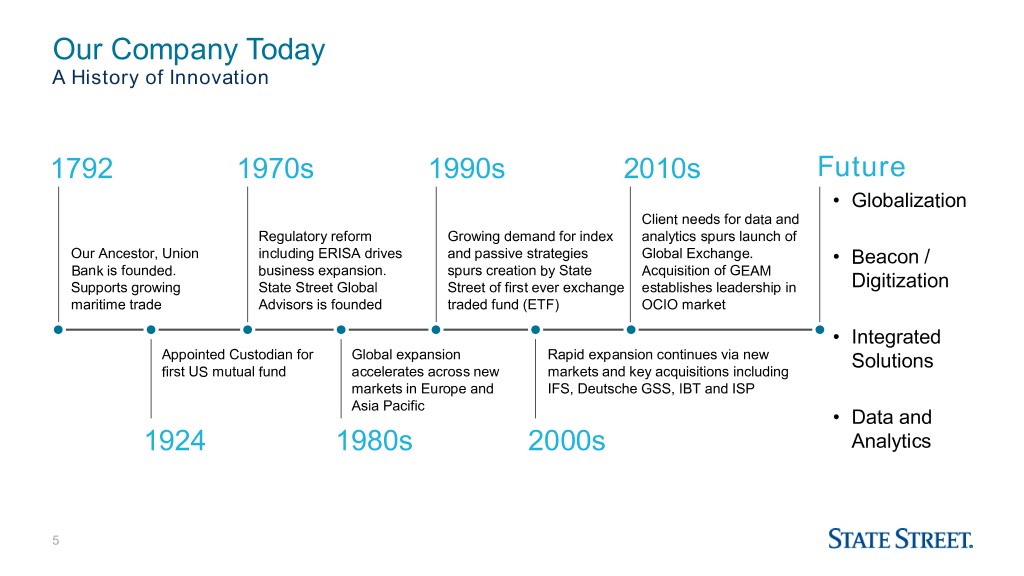
Our Company Today A History of Innovation 1792 1970s 1990s 2010s Future • Globalization Client needs for data and Regulatory reform Growing demand for index analytics spurs launch of Our Ancestor, Union including ERISA drives and passive strategies Global Exchange. • Beacon / Bank is founded. business expansion. spurs creation by State Acquisition of GEAM Supports growing State Street Global Street of first ever exchange establishes leadership in Digitization maritime trade Advisors is founded traded fund (ETF) OCIO market • Integrated Appointed Custodian for Global expansion Rapid expansion continues via new Solutions first US mutual fund accelerates across new markets and key acquisitions including markets in Europe and IFS, Deutsche GSS, IBT and ISP Asia Pacific • Data and 1924 1980s 2000s Analytics 5

Our Company Today Delivering Integrated Solutions Across Client Sectors • $33.3 trillion AUCA1 • $2.7 trillion AUM1 • One of world’s leading Asset Asset • One of largest ETF providers in investment service the world providers Managers Owners • Investment strategies across risk / • Fund accounting and return spectrum administration, custody, investment operations outsourcing Insurance Official Companies Institutions • $22 trillion in FX and interbank • Information, analytics and data solutions volume traded in 2017 • Leveraging big data and advanced • Investment research, foreign technology to offer investment indicators exchange trading and securities and analytics lending 6 1 As of March 31, 2018.
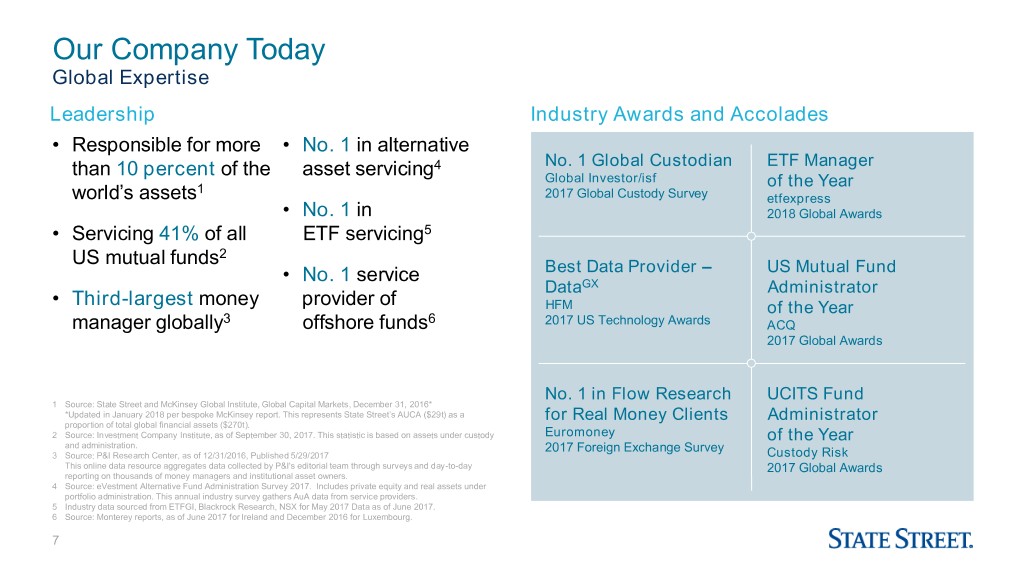
Our Company Today Global Expertise Leadership Industry Awards and Accolades • Responsible for more • No. 1 in alternative 4 No. 1 Global Custodian ETF Manager than 10 percent of the asset servicing Global Investor/isf 1 of the Year world’s assets 2017 Global Custody Survey etfexpress • No. 1 in 2018 Global Awards • Servicing 41% of all ETF servicing5 US mutual funds2 • No. 1 service Best Data Provider – US Mutual Fund DataGX Administrator • Third-largest money provider of HFM of the Year 3 6 manager globally offshore funds 2017 US Technology Awards ACQ 2017 Global Awards No. 1 in Flow Research UCITS Fund 1 Source: State Street and McKinsey Global Institute, Global Capital Markets, December 31, 2016* *Updated in January 2018 per bespoke McKinsey report. This represents State Street’s AUCA ($29t) as a for Real Money Clients Administrator proportion of total global financial assets ($270t). 2 Source: Investment Company Institute, as of September 30, 2017. This statistic is based on assets under custody Euromoney of the Year and administration. 2017 Foreign Exchange Survey 3 Source: P&I Research Center, as of 12/31/2016, Published 5/29/2017 Custody Risk This online data resource aggregates data collected by P&I's editorial team through surveys and day-to-day 2017 Global Awards reporting on thousands of money managers and institutional asset owners. 4 Source: eVestment Alternative Fund Administration Survey 2017. Includes private equity and real assets under portfolio administration. This annual industry survey gathers AuA data from service providers. 5 Industry data sourced from ETFGI, Blackrock Research, NSX for May 2017 Data as of June 2017. 6 Source: Monterey reports, as of June 2017 for Ireland and December 2016 for Luxembourg. 7
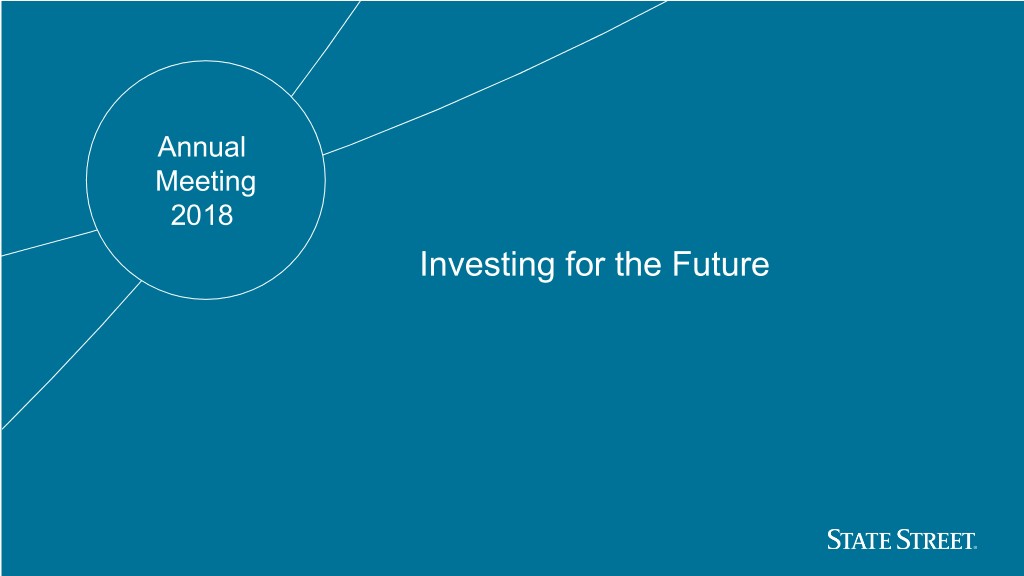
Annual Meeting 2018 Investing for the Future 8

Investing for the Future Delivering Client Solutions Secular Growth Trends Our Strategies Improved Service Enhance Client Product and Delivery Enabled Globalization Coverage Model Service Innovation by Beacon Retirement Savings • Enabling • Helping clients • Greater speed, seamless delivery navigate evolving accuracy and Heightened Regulation & Complexity and solutions regulatory accelerated time across asset environment to market classes and • Introducing • Straight through geographies solutions: processing • Innovating with − Enhanced • Real-time insights our clients Custody − Peer to Peer Lending − OCIO − Investible Indices − ESG 9

Investing for the Future State Street Beacon Digitizing $33 trillion in assets Aiming to be the digital leader in financial services Improving Speed, Quality, Transparency Enabling quicker data delivery and Client Experience Improved speed and quality with straight-through processing Delivering information the way clients need Greater flexibility and configurability of the data Leveraging advanced technologies Digital Ledger, Artificial Intelligence, Machine Learning, Cloud Expect to realize previously announced Beacon target savings of $550 million 18 months ahead of schedule by mid-2019 10

Annual Meeting 2018 Driving Returns for Shareholders 11
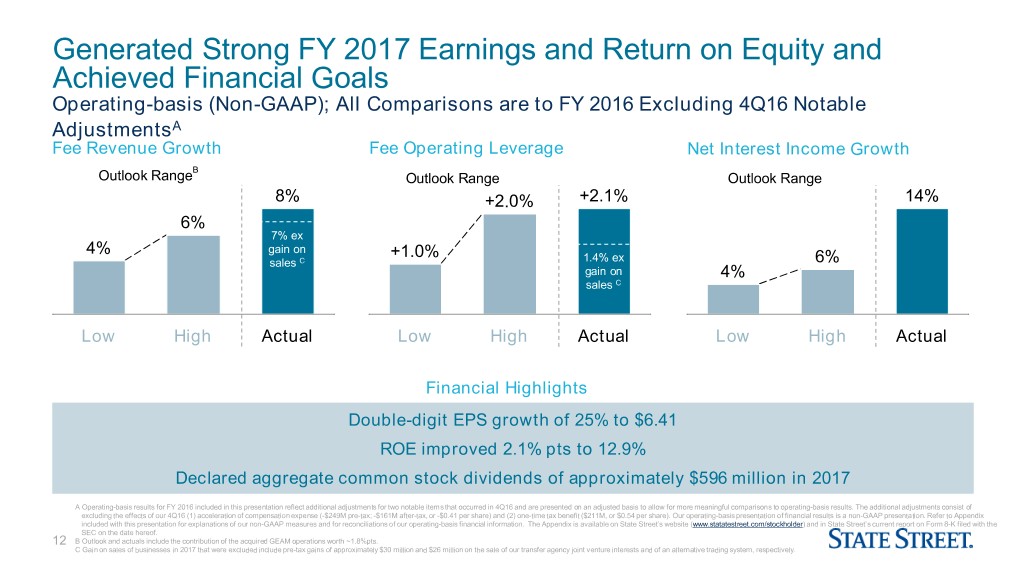
Generated Strong FY 2017 Earnings and Return on Equity and Achieved Financial Goals Operating-basis (Non-GAAP); All Comparisons are to FY 2016 Excluding 4Q16 Notable A Adjustments Fee Revenue Growth Fee Operating Leverage Net Interest Income Growth B Outlook Range Outlook Range Outlook Range 8% +2.0% +2.1% 14% 6% 7% ex 4% gain on +1.0% sales C 1.4% ex 6% gain on 4% sales C Low High Actual Low High Actual Low High Actual Financial Highlights Double-digit EPS growth of 25% to $6.41 ROE improved 2.1% pts to 12.9% Declared aggregate common stock dividends of approximately $596 million in 2017 A Operating-basis results for FY 2016 included in this presentation reflect additional adjustments for two notable items that occurred in 4Q16 and are presented on an adjusted basis to allow for more meaningful comparisons to operating-basis results. The additional adjustments consist of excluding the effects of our 4Q16 (1) acceleration of compensation expense (-$249M pre-tax; -$161M after-tax, or -$0.41 per share) and (2) one-time tax benefit ($211M, or $0.54 per share). Our operating-basis presentation of financial results is a non-GAAP presentation. Refer to Appendix included with this presentation for explanations of our non-GAAP measures and for reconciliations of our operating-basis financial information. The Appendix is available on State Street’s website (www.statatestreet.com/stockholder) and in State Street’s current report on Form 8-K filed with the SEC on the date hereof. 12 B Outlook and actuals include the contribution of the acquired GEAM operations worth ~1.8%pts. C Gain on sales of businesses in 2017 that were excluded include pre-tax gains of approximately $30 million and $26 million on the sale of our transfer agency joint venture interests and of an alternative trading system, respectively.
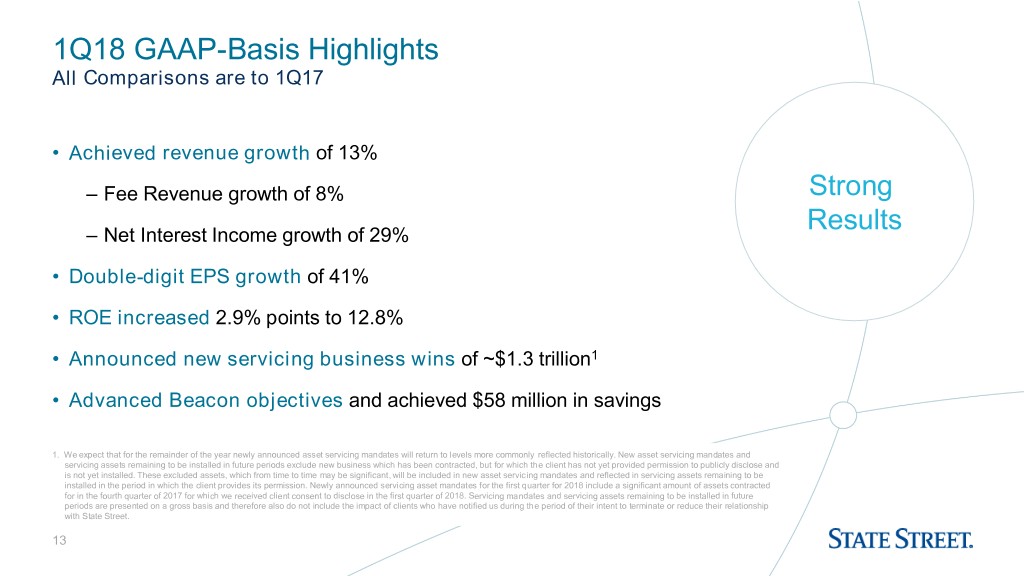
1Q18 GAAP-Basis Highlights All Comparisons are to 1Q17 • Achieved revenue growth of 13% – Fee Revenue growth of 8% Strong Results – Net Interest Income growth of 29% • Double-digit EPS growth of 41% • ROE increased 2.9% points to 12.8% • Announced new servicing business wins of ~$1.3 trillion1 • Advanced Beacon objectives and achieved $58 million in savings 1. We expect that for the remainder of the year newly announced asset servicing mandates will return to levels more commonly reflected historically. New asset servicing mandates and servicing assets remaining to be installed in future periods exclude new business which has been contracted, but for which the client has not yet provided permission to publicly disclose and is not yet installed. These excluded assets, which from time to time may be significant, will be included in new asset servicing mandates and reflected in servicing assets remaining to be installed in the period in which the client provides its permission. Newly announced servicing asset mandates for the first quarter for 2018 include a significant amount of assets contracted for in the fourth quarter of 2017 for which we received client consent to disclose in the first quarter of 2018. Servicing mandates and servicing assets remaining to be installed in future periods are presented on a gross basis and therefore also do not include the impact of clients who have notified us during the period of their intent to terminate or reduce their relationship with State Street. 13
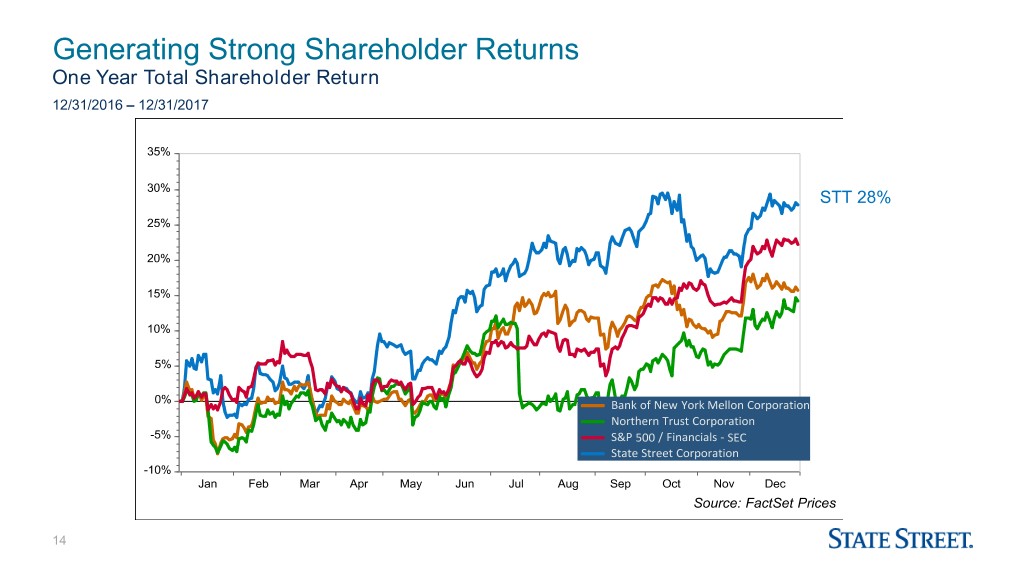
Generating Strong Shareholder Returns One Year Total Shareholder Return 12/31/2016 – 12/31/2017 STT 28% 14

Annual Meeting 2018 Our Impact 15

Corporate Citizenship* 2017 Results Community • Contributed US$20.3 million in strategic grants and employee matching Investments gifts funding during 2017 in 34 communities around the world Employee • 123,300 volunteer hours donated; 3,377 employees and members of our Involvement Board of Directors participated in the Matching Gifts program • Gifts matched impacted 2,365 charitable organizations Corporate • Launched Science-Based Targets for reduction in CO2 emissions (30% Responsibility goal); water usage (10% goal); and recycling (80% goal) by 2025 (based on 2015 baseline) • Published a new human trafficking/slavery statement that outlines State Street’s approach to banning those practices in its hiring and supply chain management; worked with GHR and Procurement teams to develop stronger policies in this area • Enhanced ESG product and service offerings by expansion of SSGA ESG team and launch of GX ESG Solutions • Prepared for new CR reporting requirements in European Union, as well as for Task Force on Climate-Related Financial Disclosures update; satisfied both with publication of 2017 CR Report • Industry recognition included FTSE4Good Index, Dow Jones Sustainability Index, MSCI ESG Risk Ratings – AA Rating, CR Magazine *All data as of December 31, 2017. Top 100 (top-rated bank in US) 16

Boston WINs* Our Commitment • $20 million to advance systematic, scalable and measurable approach to college and career readiness • Hire 1,000 aspiring professionals to strengthen our workforce • Manage and measure initiative – 2015 through 2019 Our Approach • A unique private, public, non-profit partnership centered around college and career readiness • Working in close collaboration with Boston Public Schools to create and sustain systems change • Supporting organizational strength of partner organizations through capacity and capability building Our Progress • 27,881 youth served1 • Scaled model from five to 26 Boston Public High Schools • 973 internship experiences, 444 full-time and trainee hires 17 *All data as of December 31, 2017, unless otherwise noted. 1 As of June 30, 2017.

Commitment to Inclusion & Diversity* Highlights Awards & Recognition • Recognized by The Times as a Top 50 Employer for Women for the 6th year in a row • Received 100% on the Human Rights Campaign’s Corporate Equality Index for the 4th year in a row • Recognized as a 2020 Women on Boards Winning “W” Company • Established a new set of diversity goals for the year 2022, including more aggressive three and five year targets for gender (global) and employees of color (US) • Increased executive leadership diversity with four female Management Committee members • Fearless Girl is advancing gender diversity across the industry *All data as of April 25, 2018, unless otherwise noted. 18

Annual Meeting 2018 Building on Our Strategy to Deliver Shareholder Value Wednesday, May 16, 2018 19

STATE STREET CORPORATION RECONCILIATIONS OF OPERATING-BASIS (NON-GAAP) FINANCIAL INFORMATION In addition to presenting State Street's financial results in conformity with U.S. generally accepted accounting principles, or GAAP, management has also historically (and in this Supplemental Information Package) presented results on a non-GAAP, or operating-basis or otherwise adjusted bases. Management believed this presentation would support additional meaningful analysis and comparisons of trends with respect to State Street's business operations from period to period. Management may also provide (and in this Supplemental Information Package has provided) additional non-GAAP measures, including capital ratios calculated under regulatory standards scheduled to be effective in the future or other standards, that management uses in evaluating State Street’s business and activities. Our operating-basis, or otherwise adjusted basis, financial results have historically adjusted our GAAP-basis financial results to both: (1) exclude the impact of revenue and expenses outside of State Street’s normal course of business, such as restructuring charges; and (2) present revenue from non-taxable sources, such as interest income from tax-exempt investment securities and processing fees and other revenue associated with tax-advantaged adjustments, on a fully taxable-equivalent basis. Management believed that this presentation of financial information facilitates an investor's further understanding and analysis of State Street's financial performance and trends, including providing additional insight into our underlying margin and profitability, in addition to financial information prepared and reported in conformity with GAAP. The tax-equivalent adjustments allow for more meaningful comparisons of yields and margins on assets and the evaluation of investment opportunities with different tax profiles. Beginning with the first quarter of 2017, we began simplifying our operating-basis presentation of our financial results to no longer exclude, as part of the non-ordinary course adjustment, the effects of gains/losses on sales of businesses or the discount accretion associated with former conduit securities. In the first and third quarters of 2017, operating-basis results included a pre-tax gain of approximately $30 million on the sale of our transfer agency joint venture interests and a pre-tax gain of approximately $26 million on the sale of an alternative trading system, respectively. In the first, second, third, and fourth quarters of 2017, operating-basis results included $5 million, $6 million, $4 million and $4 million, respectively, of discount accretion. These changes resulted in total increases in operating-basis revenue of $35 million, $6 million, $30 million and $4 million in the first, second, third and fourth quarters of 2017, respectively, relative to our historical operating-basis presentation. Note that in the second quarter of 2016, operating-basis results excluded a pre-tax gain of approximately $53 million on the sale of the WM/Reuters business. We believe that these changes to our operating-basis presentation simplify the overall presentation of our financial results, making them easier to understand, while, overall, continuing to facilitate a useful and helpful additional understanding of our financial results. Certain of our financial metrics have been adjusted to exclude certain notable items in 4Q16 and 4Q17 as well as full year 2016 and 2017. Such notable items consist of: 4Q17 GAAP results reflect a 4Q17 one- time net $270 million (-$0.72 per share) related to recently enacted tax law of which $250 million is recorded in tax expense and $20 million is recorded as a reduction in revenue, and, in 4Q16 both GAAP and operating-basis results reflected a tax benefit of $211 million ($0.54 per share) and acceleration of compensation expense of $249 million ($161 million after-tax, or -$0.41 per share) for a combined net benefit of $0.13 per share. Our presentation of financial results excluding notable items, as well as our presentation of operating-basis financial results generally, are non-GAAP presentations. The final impact of the recently enacted tax law may differ from these estimates, due to additional guidance from the taxing authorities and changes in State Street assumptions and interpretations. We also believe that the use of other non-GAAP financial measures in the calculation of identified capital ratios is useful to understanding State Street's capital position and is of interest to investors. Additionally, management may present revenue and expense measures on a constant currency (non-GAAP) basis to identify the significance of changes in foreign currency exchange rates (which often are variable) in period-to-period comparisons. This presentation represents the effects of applying prior period weighted average foreign currency exchange rates to current period results. We provide forward-looking financial estimates and expectations on an operating basis (non-GAAP) because information needed to provide corresponding GAAP-basis information is primarily dependent on future events or conditions that may be uncertain and are difficult to predict or estimate. Management is therefore, in general, unable to provide a reconciliation of our operating-basis forward-looking financial estimates and expectations to a GAAP-basis presentation. Non-GAAP financial measures should be considered in addition to, not as a substitute for or superior to, financial measures determined in conformity with GAAP. 20
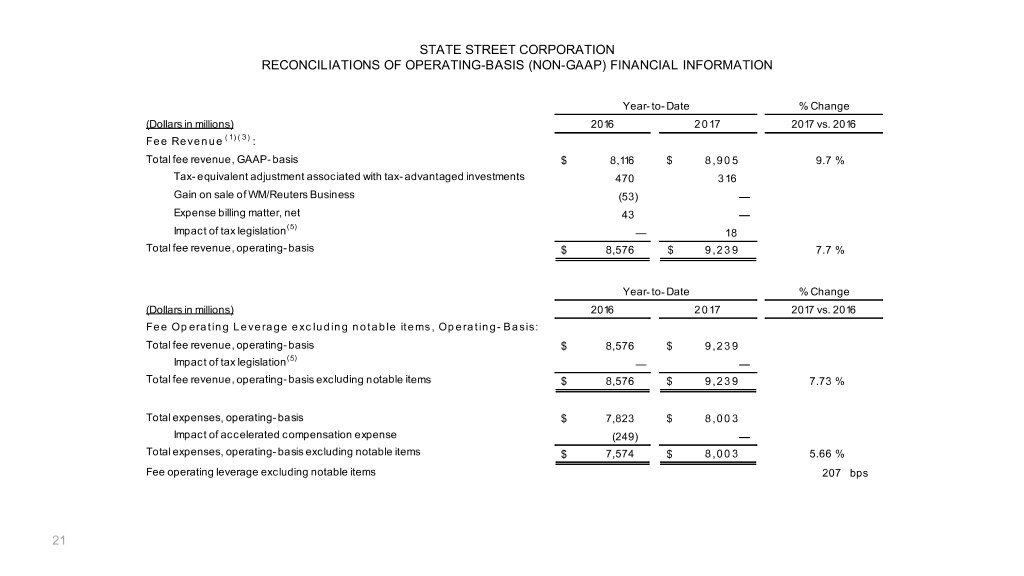
STATE STREET CORPORATION RECONCILIATIONS OF OPERATING-BASIS (NON-GAAP) FINANCIAL INFORMATION Year- to- Date % Change (Dollars in millions) 2016 2 0 17 2017 vs. 2016 Fe e Re ve nue ( 1) ( 3 ) : Total fee revenue, GAAP- basis $ 8,116 $ 8 ,9 0 5 9.7 % Tax- equivalent adjustment associated with tax- advantaged investments 470 3 16 Gain on sale of WM/Reuters Business (53) — Expense billing matter, net 43 — (5) Impact of tax legislation — 18 Total fee revenue, operating- basis $ 8,576 $ 9 ,2 3 9 7.7 % Year- to- Date % Change (Dollars in millions) 2016 2 0 17 2017 vs. 2016 Fe e Ope ra ting Le ve ra ge e xc luding nota ble ite ms, Ope ra ting- Ba sis: Total fee revenue, operating- basis $ 8,576 $ 9 ,2 3 9 (5) Impact of tax legislation — — Total fee revenue, operating- basis excluding notable items $ 8,576 $ 9 ,2 3 9 7.73 % Total expenses, operating- basis $ 7,823 $ 8 ,0 0 3 Impact of accelerated compensation expense (249) — Total expenses, operating- basis excluding notable items $ 7,574 $ 8 ,0 0 3 5.66 % Fee operating leverage excluding notable items 207 bps 21

STATE STREET CORPORATION RECONCILIATIONS OF OPERATING-BASIS (NON-GAAP) FINANCIAL INFORMATION Year- to- Date % Change (Dollars in millions) 2016 2 0 17 2017 vs. 2016 Ne t Inte re st Inc ome ( 2 ) ( 4 ) : Net interest income, GAAP- basis $ 2,084 $ 2 ,3 0 4 10.6 % Tax- equivalent adjustment associated with tax- exempt investment securities 167 16 7 Net interest income, fully taxable- equivalent basis 2,251 2 ,4 7 1 Net interest income, fully taxable- equivalent basis $ 2,251 $ 2 ,4 7 1 (5) Impact of tax legislation — 2 Discount accretion associated with former conduit securities (82) — Net interest income, operating- basis $ 2,169 $ 2 ,4 7 3 14.0 % Year- to- Date % Change 2016 2 0 17 2017 vs. 2016 Dilute d Ea rnings pe r Common Sha re ( 1) ( 2 ) : Diluted earnings per common share, GAAP- basis $ 4.97 $ 5 .2 4 5.4 % Severance costs associated with staffing realignment (.02) — Provisions for legal contingencies .13 — Expense billing matter, net .10 — Acquisition costs .11 .0 3 Restructuring charges, net .21 .4 3 (5) Impact of tax legislation — .7 2 Discount accretion associated with former conduit securities (.13) — Gain on sale of WM/Reuters Business (.10) — Diluted earnings per common share, operating- basis $ 5.27 $ 6 .4 1 21.6 % 22

STATE STREET CORPORATION RECONCILIATIONS OF OPERATING-BASIS (NON-GAAP) FINANCIAL INFORMATION Year- to- Date % Change 2016 2 0 17 2017 vs. 2016 Re turn on Ave ra ge Common Equity ( 1) ( 2 ) : Return on average common equity, GAAP- basis 10.5 % 10 .6 % 10 bps Severance costs associated with staffing realignment —% —% Provisions for legal contingencies .3 % —% Expense billing matter, net .2 % —% Acquisition costs .2 % .1 % Restructuring charges, net .4 % .8 % (5) Impact of tax legislation —% 1.4 % Discount accretion associated with former conduit securities (.3)% —% Gain on sale of WM/Reuters Business (.2)% —% Return on average common equity, operating- basis 11.1 % 12 .9 % 180 bps (1) The first and third quarters of 2017 GAAP-basis and operating-basis results include a pre-tax gain of approximately $30 million on the sale of our transfer agency joint venture interests and a pre-tax gain of approximately $26 million on the sale of an alternative trading system, respectively, reflecting a change in our operating-basis presentation effective the first quarter of 2017 to include gains/losses on sales of businesses. In the second quarter of 2016, under our historical presentation, operating- basis results excluded a $53 million pre-tax gain on the sale of WM /Reuters business, and such results have not been revised. (2) Beginning in the first quarter of 2017, management no longer presents discount accretion associated with former conduit securities as an operating-basis adjustment. Therefore, the first, second, third and fourth quarters of 2017 GAAP and operating-basis results included $5 million, $6 million, $4 million and $4 million, respectively, of discount accretion. In the first, second, third and fourth quarters of 2016, operating-basis net interest income excluded $15 million, $15 million, $42 million and $10 million of discount accretion, respectively, and such results have not been revised. (3) The impact of acquired operations on total revenue and fee revenue contributed approximately $65 million, $64 million, $71 million, and $72 million for the third and fourth quarters of 2016 and first and second quarters of 2017, respectively. The impact of acquired operations on expenses contributed approximately $57 million, $58 million, $51 million, and $51 million for the third and fourth quarters of 2016 and first and second quarters of 2017, respectively, excluding merger and integration charges and financing costs. (4) Net interest income on an operating-basis is also adjusted to reflect th impact of discount accretion for full year 2016 and the impact of tax legislation for full year 2017. (5) 23 The effects of the TCJA described in this presentation are estimates. Actual effects of the TCJA may differ from these estimates, among other things, due to additional tax and regulatory guidance and changes in State Street assumptions and interpretations.
